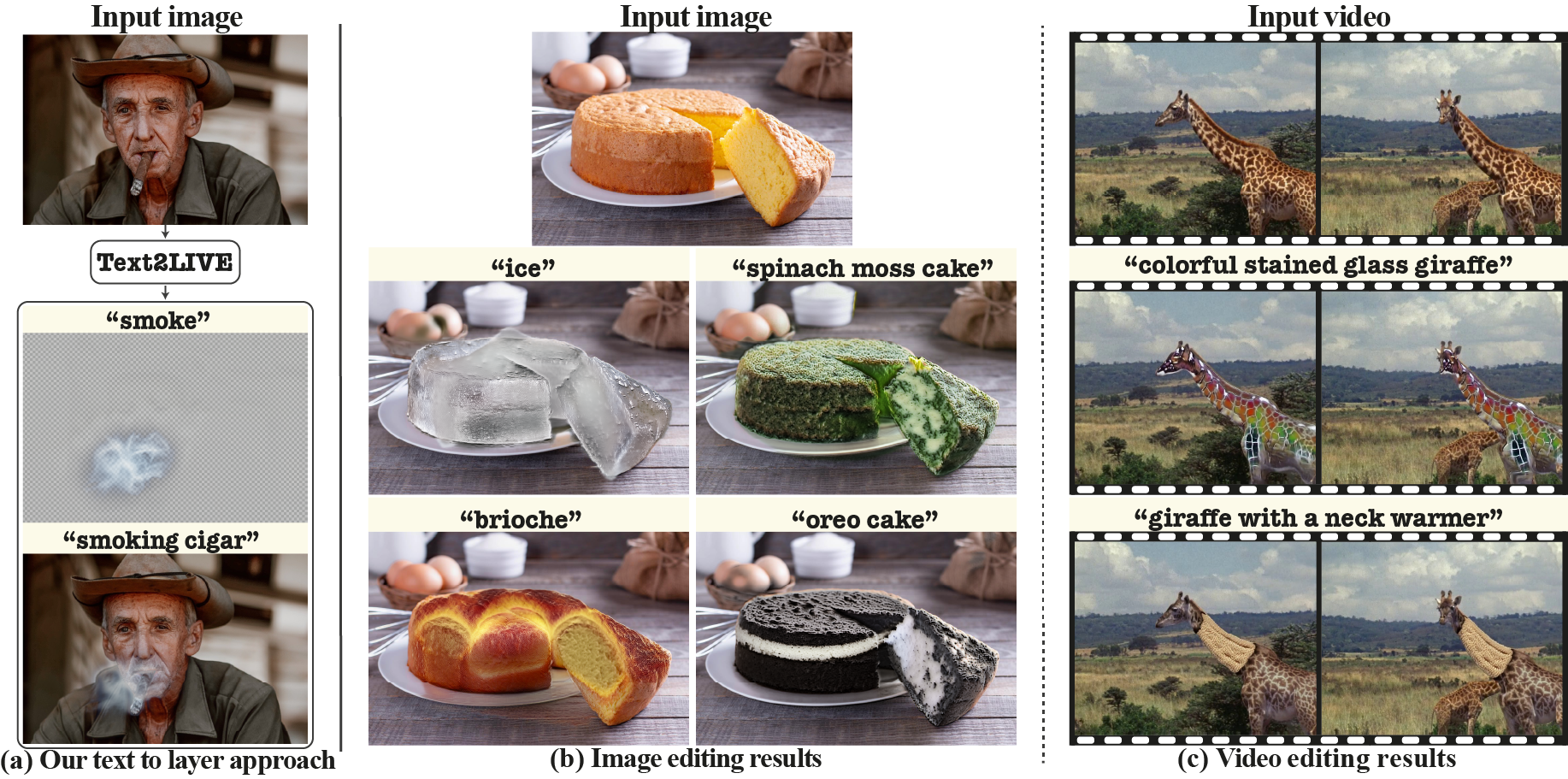Spaces:
Configuration error
Configuration error
| # Text2LIVE: Text-Driven Layered Image and Video Editing (ECCV 2022 - Oral) | |
| ## [<a href="https://text2live.github.io/" target="_blank">Project Page</a>] | |
| [](https://arxiv.org/abs/2204.02491) | |
|  | |
| [](https://huggingface.co/spaces/weizmannscience/text2live) | |
|  | |
| **Text2LIVE** is a method for text-driven editing of real-world images and videos, as described in <a href="https://arxiv.org/abs/2204.02491" target="_blank">(link to paper)</a>. | |
| [//]: # (. It can be used for localized and global edits that change the texture of existing objects or augment the scene with semi-transparent effects (e.g. smoke, fire, snow).) | |
| [//]: # (### Abstract) | |
| >We present a method for zero-shot, text-driven appearance manipulation in natural images and videos. Specifically, given an input image or video and a target text prompt, our goal is to edit the appearance of existing objects (e.g., object's texture) or augment the scene with new visual effects (e.g., smoke, fire) in a semantically meaningful manner. Our framework trains a generator using an internal dataset of training examples, extracted from a single input (image or video and target text prompt), while leveraging an external pre-trained CLIP model to establish our losses. Rather than directly generating the edited output, our key idea is to generate an edit layer (color+opacity) that is composited over the original input. This allows us to constrain the generation process and maintain high fidelity to the original input via novel text-driven losses that are applied directly to the edit layer. Our method neither relies on a pre-trained generator nor requires user-provided edit masks. Thus, it can perform localized, semantic edits on high-resolution natural images and videos across a variety of objects and scenes. | |
| ## Getting Started | |
| ### Installation | |
| ``` | |
| git clone https://github.com/omerbt/Text2LIVE.git | |
| conda create --name text2live python=3.9 | |
| conda activate text2live | |
| pip install -r requirements.txt | |
| ``` | |
| ### Download sample images and videos | |
| Download sample images and videos from the DAVIS dataset: | |
| ``` | |
| cd Text2LIVE | |
| gdown https://drive.google.com/uc?id=1osN4PlPkY9uk6pFqJZo8lhJUjTIpa80J&export=download | |
| unzip data.zip | |
| ``` | |
| It will create a folder `data`: | |
| ``` | |
| Text2LIVE | |
| ├── ... | |
| ├── data | |
| │ ├── pretrained_nla_models # NLA models are stored here | |
| │ ├── images # sample images | |
| │ └── videos # sample videos from DAVIS dataset | |
| │ ├── car-turn # contains video frames | |
| │ ├── ... | |
| └── ... | |
| ``` | |
| To enforce temporal consistency in video edits, we utilize the Neural Layered Atlases (NLA). Pretrained NLA models are taken from <a href="https://layered-neural-atlases.github.io">here</a>, and are already inside the `data` folder. | |
| ### Run examples | |
| * Our method is designed to change textures of existing objects / augment the scene with semi-transparent effects (e.g., smoke, fire). It is not designed for adding new objects or significantly deviating from the original spatial layout. | |
| * Training **Text2LIVE** multiple times with the same inputs can lead to slightly different results. | |
| * CLIP sometimes exhibits bias towards specific solutions (see figure 9 in the paper), thus slightly different text prompts may lead to different flavors of edits. | |
| The required GPU memory depends on the input image/video size, but you should be good with a Tesla V100 32GB :). | |
| Currently mixed precision introduces some instability in the training process, but it could be added later. | |
| #### Video Editing | |
| Run the following command to start training | |
| ``` | |
| python train_video.py --example_config car-turn_winter.yaml | |
| ``` | |
| #### Image Editing | |
| Run the following command to start training | |
| ``` | |
| python train_image.py --example_config golden_horse.yaml | |
| ``` | |
| Intermediate results will be saved to `results` during optimization. The frequency of saving intermediate results is indicated in the `log_images_freq` flag of the configuration. | |
| ## Sample Results | |
| https://user-images.githubusercontent.com/22198039/179797381-983e0453-2e5d-40e8-983d-578217b358e4.mov | |
| For more see the [supplementary material](https://text2live.github.io/sm/index.html). | |
| ## Citation | |
| ``` | |
| @article{bar2022text2live, | |
| title = {Text2LIVE: Text-Driven Layered Image and Video Editing}, | |
| author = {Bar-Tal, Omer and Ofri-Amar, Dolev and Fridman, Rafail and Kasten, Yoni and Dekel, Tali}, | |
| journal = {arXiv preprint arXiv:2204.02491}, | |
| year = {2022} | |
| } | |
| ``` | |